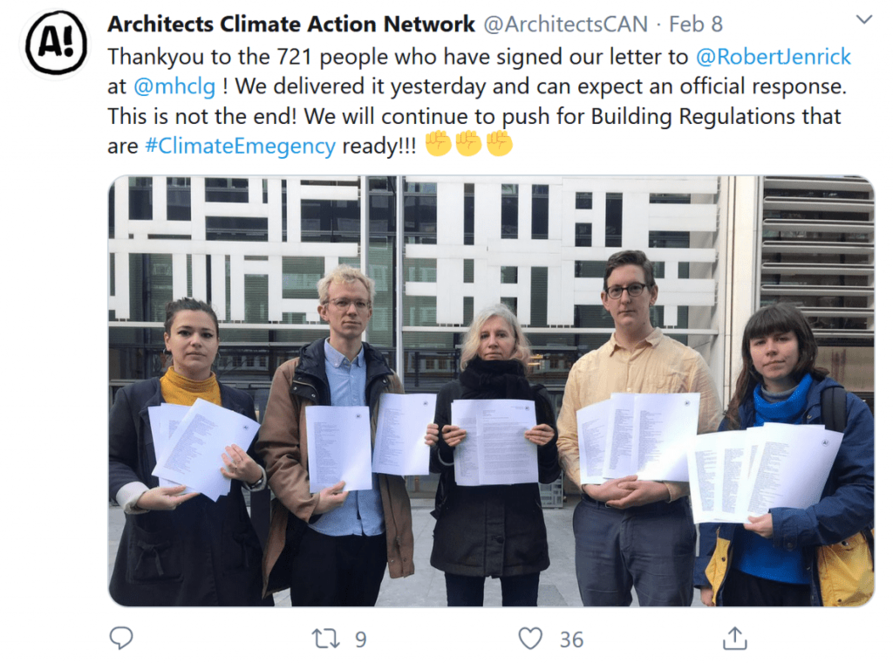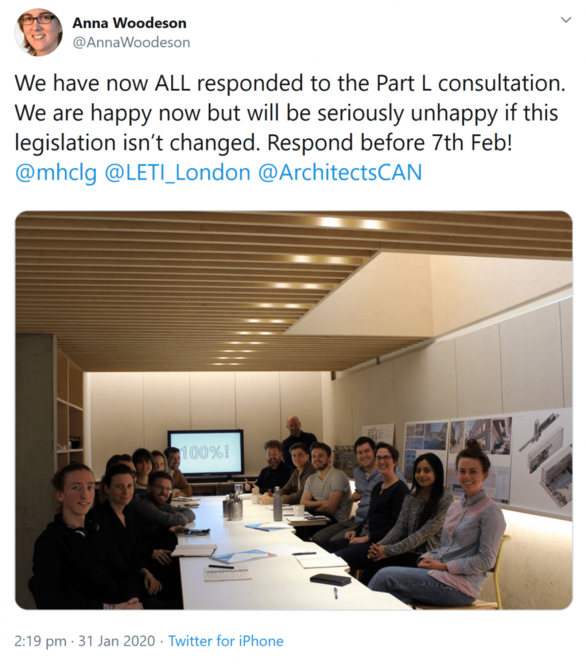Rebellion! Construction activists fighting against climate change
Construction professionals are rising up and challenging the status quo. Is campaigning in paid working hours, and even risking arrest, the kiss of death to your business and your career? Or is this a new kind of professionalism – one that is becoming an absolute necessity, for the construction industry & the planet?
Back in 2012 the UK government consulted the construction industry about an update to Part L of the building regulations (the energy standards for new homes in England ). Just 53 designers, engineers and surveyors took the trouble to respond with their views.
In autumn 2019, the UK government published a consultation on the next upgrade to these same standards. The response could hardly have been more different.

Extinction Rebellion 2019 at Waterloo Bridge - Photo by Mark Ramsay
Proposals miss the zero emissions target
Despite the government’s announcement of a national target of net zero emissions by 2050, and despite the declaration by the then parliament of a climate emergency, the proposals appeared to make just a minor advance on the regulations passed in 2013.
As word spread about the disappointing proposals – and in particular, the proposal to ban local authorities from setting their own, higher construction standards – dismay mounted.
The day before the consultation closed, amid a crescendo of social media posts and newspaper articles , a group of Extinction Rebellion activists gathered outside the Ministry of Housing in central London, carrying placards and beating drums. A colourful ‘tug of war’ was staged, dramatising the struggle between local authorities striving to cut emissions, and the government pulling back against them.
Architects Protest
Construction professionals were there too – members of the Architects Climate Action Network brought placards and made speeches explaining their view that the government’s proposals were “irresponsible and damaging” in view of the climate emergency.
A public link-up between professional architects and street protesters might have seemed unlikely few years ago, but in 2020, building professionals are taking to the streets.

Architects Climate Action Network (https://twitter.com/ArchitectsCAN) delivering a letter to MHCL
Eyecatching actions
Extinction Rebellion (XR) shot to prominence in 2019, in the wake of Greta Thunberg’s School Strike for Climate, and the IPCC’s “Final Call” to save the world from climate catastrophe.
The movement stages eye-catching high-impact mass actions to draw national attention to the urgency of the climate crisis. Last April Extinction Rebellion installed a brightly-painted boat – symbolising London’s vulnerability to rising sea levels – at Oxford Circus, the heart of the West End’s main shopping street. It became the focus of speeches, music and dancing that completely blocked the traffic. Waterloo Bridge – a central river crossing – was blockaded and transformed into a temporary garden and play space, filled with trees, skate ramps, and even yoga classes. A new series of events began in the UK this February.
Public reaction to the disruption was generally remarkably tolerant. The protests seemed both to reflect and amplify a changing public mood: a majority of ordinary people in the UK believe not enough is being done to tackle climate change.
Professionals on the front line
Over 1000 activists were arrested, mostly after refusing to move when told to by police. Among them were construction professionals Piers Sadler (a Passivhaus consultant) and architect Tom Bennett.
A photograph of Piers Sadler being carried away by police appeared in the Sun newspaper, which printed his “letter to the nation”, written in a police cell, explaining why he had taken the action he did:
“I have never been an activist, nor have I been arrested before,” he wrote, explaining that he risked arrest as a “heartfelt attempt” to do whatever he could, to try to limit the potentially devastating impacts of climate change.
Tom Bennett’s case was particularly high profile as, rather than being released without charge as many protesters were, he was prosecuted, and found guilty of breaching the Public Order Act.
Any architect who receives a conviction has to declare this to the Architects Registration Board (ARB ), which has the power to determine if an individual is fit to practice, or if they should be struck off.
Tom Bennett was aware of this when he joined the protest – and to begin with he was wary. “When Extinction Rebellion came along I felt like I had to support them and get involved. But when I joined the action in central London I had not planned to get arrested. Partly I was concerned in terms of my job prospects, and the possible impact on my ability to travel.”
“But then I realised that if no-one was willing to face arrest, it would be very easy for the police to clear the protests, and we would not have the same impact and staying power. In the end I felt if other people were willing to take that step, there was no reason for me not to as well. I am glad I did.”
Serving the public interest
The ARB considered his case but opted not to take any disciplinary action. Writing in the RIBA journal afterwards, Tom reflected on the importance of people taking action like his where they can. He pointed out that the strategy of disruptive street protest has powerful historical precedent – for example, in movements to abolish slavery, or secure votes for women.
“As a profession architects have a duty to serve the public interest; I’ve viewed my action as a natural extension of that duty”
Piers Sadler owns his own consultancy; Tom Bennett however works for a small practice, Studio Bark – but they have been extremely supportive, he says. This response is not unique. Inspired by the commitment of Piers Sadler and others, Toby Cambray and Hannah Jones, who run building engineering practice Greengauge, told staff that they will be supported – even to the extent of receiving pay and legal support – if they are arrested in a climate action.
Another kind of activism
Not everyone is willing or able to be physically carried from the streets by police officers. But many construction professionals are trying hard to respond urgently to the environmental crisis, and are throwing themselves into activism of other kinds.
In response to the government’s Part L consultation, people stood in conference rooms and denounced the proposals for their lack of ambition – to loud applause. Packed meetings of architects and engineers exchanged notes on how they should push the government into doing more.
In the final week of the consultation period, social media saw images of rooms full of architects and engineers, hunched over computers and filling out their consultation responses, fuelled by a wave of fellow feeling – and employer-provided cake. Hundreds of professionals signed a letter to the government setting out their objections.

Anna Woodeson (https://twitter.com/AnnaWoodeson/status/1223249529518149638?s=20) on Twitter
Among those driving this vigorous response were Architects Climate Action Network – who joined Extinction Rebellion outside the housing ministry. ACAN grew out of a conversation between a small group of architects participating in the XR actions in central London, but is equally committed to other kinds of activism, as member Kat Scott explains.
“We set up ACAN partly because we were looking for ways that all professionals could contribute, even if they don’t feel that participating in an Extinction Rebellion action is the best use of their agency – or if their employer might not accept it.”
The group has been thinking a lot about what is the most effective was for architects to act. ”We are asking ourselves what being a professional means in the context of the climate emergency.”
ACAN has close links to another activist group LETI (the London Energy Transformation Initiative) – which in turn works closely with bodies such as CIBSE (the Chartered Institute of Building Services Engineers) and the Passivhaus Trust.
LETI was first brought together by engineer Clara Bagenal George of consultancy Elementa, for the construction industry to respond collectively to concerns about local construction standards – those specific to London. But the group has grown very rapidly and extended its influence way beyond the local.
Professionals must collaborate
LETI seems to have tapped into the urgent desire of professionals to work together to change the way we build in the UK and has led to a remarkable scale of collaboration. In the recently published LETI Climate Emergency design guide , two closely printed pages list the names of over 100 contributors.

Architects Climate Action Network (https://twitter.com/ArchitectsCAN) on Twitter
As Clara Bagenal George said at the guide’s launch: “We’re not in a competition here”. If only a few leading practices manage to achieve the necessary standards, the climate emergency battle will be lost. Every building has to get to net zero, and not just a few exemplars; and the only way this will happen will be if everyone collaborates, she insisted.
LETI also produced – again collaboratively – a comprehensive ‘model response’ to the Part L proposals – complete with calculations to back the arguments. The response was very widely shared and this time around, hundreds – possibly thousands – of construction professionals submitted informed responses to the government. At a meeting hosted by the RIBA (Royal Institute of British Architects) an MHCLG official reportedly said that the ministry had received over 4000 responses. Officials have admitted the scale of the response has taken them by surprise.

Architects Climate Action Network (https://twitter.com/ArchitectsCAN/status/1232675267321135105?s=20) on Twitter

Judit Kimpian (https://twitter.com/JuditKimpian/status/1232620756653215745?s=20) on Twitter
Kat Scott and Clara Bagenal George have both been supported by their employers – both have been given regular time in their working week to carry out work for LETI. Employers too are seeing that things must change.
Jonas Lencer, a director with Kat Scott’s employer dRMM recently blogged that young people are ready to abandon the status quo – and established organisations should follow their lead. Making only small changes, using “commercial necessity” as an excuse, was no longer acceptable, he said.
Is there a commercial risk in activism?
Although investing staff time in collaborative projects rather than individual client contracts might appear commercially risky, Kat Scott believes this will not necessarily put firms like dRMM at a disadvantage – and may indeed prove the opposite. “It is useful for the firm to have evidence that we know what we are talking about, that we have really thought about this.”
“When we are going for new projects it is a core part of our bids to be explicit about our commitment. We have clients who are large developers saying ‘this is great’ – I think there are pioneering clients just as there are pioneering architects and engineers. The forward looking clients and landowners want to be leaders. They responded to Part L too, they attended the LETI events, they take it seriously.”
Whether it is via speaking out at conferences, posting images on social media, or attending demonstrations and actions demonstrations, visibility is key to professional activism, Kat Scott says. “If you state as a profession ‘this is a problem’ you are taking advantage of the agency that comes with having specialist knowledge,” she says.
“I think it is uniquely effective to have professionals expressing their concern so visibly – in the past this has been a rather formal, quiet process, but as professionals now, we want to achieve visible evidence, we really want to be seen, we want it to be known.”
Activism for all?
We won’t know for a while whether the surge of criticism of the recent building regulations proposals leads the government to a rethink. But the spirit of rebellion is abroad. Some professionals and some clients are making up their own minds about the standards we should build to – and, crucially, making sure as many people as possible know it.
This spirit has by no means swept the whole construction industry. There is a very long way to go before all buildings in the UK are as energy efficient as they need to be to meet our climate goals. What is remarkable though is the pace of change – and the willingness to seize the initiative and challenge the status quo.
Committing publicly to the drive to zero carbon puts an obligation on practitioners to be accountable, to be transparent, and to follow through in practice. While street activism is not for everyone, all of us can take responsibility for our part in the climate fight.
All of us can challenge the status quo when it isn’t good enough. All of us can challenge ourselves. If we are going to get on top of the climate crisis, it is hard to avoid the conclusion that all of us must.
Kate de Selincourt
Kate is a writer and researcher specialising in sustainable and healthy building and retrofit.